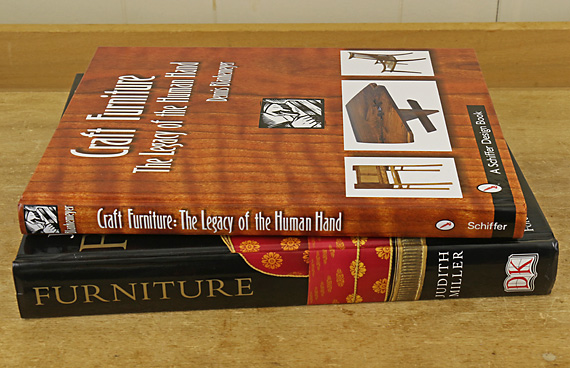
One of the best ways to develop your design skills is to look thoughtfully at lots of furniture, including unfamiliar work. Books and collections that organize work in historical and stylistic context are especially helpful learning tools. Here are two books that are both worthwhile but differ greatly in approach.
Furniture by Judith Miller (Dorling Kindersley Publishing) covers furniture design from ancient Egypt to contemporary. [Note: At Amazon, the larger format 2005 American edition is now much more expensive than the slightly smaller format 2010 UK edition.]
Done in the beautiful and orderly style typical of DK Publishing, the more than 500 pages will supply you with plenty of browsing hours. It is organized primarily by time period, for example 1760-1800, then by country and style, for example late 18th century Scandinavian. I like best the several sections within each time period that are devoted to specific furniture types, which allow you to study, for example, tables in the Art Deco period of 1919-1940.
Even though anything I design and make is unlikely to directly emulate more than a few, if any, of the pieces in this book, there are lots of stimulating ideas, motifs to borrow, and much to learn just from studying a wide variety of good design.
That’s the good part of the book. Now for the bad and the ugly. It is painful enough just to look at much of the furniture in the “Postmodern and Contemporary – 1970 Onward” chapter, but it is exacerbated by reading the highbrow credibility given by the author to some of this crap.
There is no Maloof rocker or Krenov cabinet to found here, though we are informed that Castle, Maloof, and Frid “worked in a highly contrived Postmodern style.” Further, the author states, “Using a laborious, painstaking method to produce off-hand, jokey objects was self-consciously ironic.”
Administer relief to yourself from such nonsense by picking up Craft Furniture by Dennis Blankemeyer (Schiffer Publishing, 2003). The author does an outstanding job of placing this work in the context of our daily lives and, more broadly, in our spiritual lives. He also gives fitting tribute to craftsmanship.
After sections on Esherick, Krenov, Maloof, and Nakashima, he presents the work and background of 25 contemporary craftspeople. There is so much beautiful, honest woodwork here; I think readers are sure to find it inspirational.
I suspect this book has not gotten the attention that it deserves. It is available in only hardcover from Amazon and Barnes and Noble.
Resolving the different vantage points of these two authors is a matter for another day. I’d rather get back to the shop.


I have Judith Millers book “Furniture” as well. She also made a book called “Chairs” that I am fond of as a chairmaker. Now I have to order the “Craft Furniture” book to add to my collection. Thanks for the post.
Hi Brian,
Thanks for the comment and thanks for reading.
As a chairmaker, here’s another book I think you’d enjoy, if you haven’t already seen it:
http://www.cambiumbooks.com/books/chair_making/1579908721/
It’s part of Lark Books’ 500 series:
http://www.rpwoodwork.com/blog/2011/01/30/good-sources-for-design-ideas/
Rob
Rob,
Thanks for sharing these books. They seem to be quite interesting. I am gonna check them out now !
Enjoy them, Neeta!
Rob